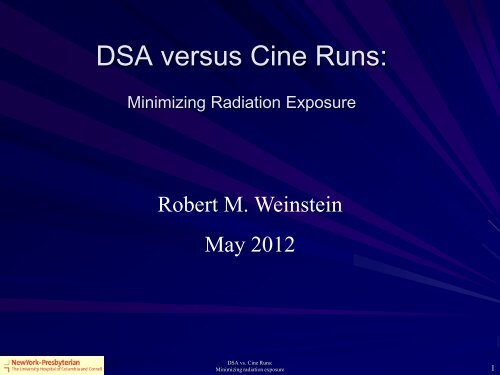DSA versus Cine Runs: Minimizing radiation exposure
DSA versus Cine Runs: Minimizing radiation exposure
DSA versus Cine Runs: Minimizing radiation exposure
- No tags were found...
You also want an ePaper? Increase the reach of your titles
YUMPU automatically turns print PDFs into web optimized ePapers that Google loves.
<strong>DSA</strong> <strong>versus</strong> <strong>Cine</strong> <strong>Runs</strong>:<strong>Minimizing</strong> Radiation ExposureRobert M. WeinsteinMay 2012<strong>DSA</strong> vs. <strong>Cine</strong> <strong>Runs</strong>:<strong>Minimizing</strong> <strong>radiation</strong> <strong>exposure</strong> 1
Objectives• Have an understanding of <strong>DSA</strong> and cineangiography and their differences.• Have an understanding of the advantages of<strong>DSA</strong> over cine angiography.• Be able to understand and utilize all theadvantages that <strong>DSA</strong> offers.<strong>DSA</strong> vs. <strong>Cine</strong> <strong>Runs</strong>:<strong>Minimizing</strong> <strong>radiation</strong> <strong>exposure</strong>2
<strong>DSA</strong>or<strong>Cine</strong> Angiography• What is Angiography?• Angiography or arteriography is a medicalimaging technique in which an X-ray picture istaken to visualize the inner opening (lumen) ofblood filled structures, including arteries, veinsand the heart chambers. Its name comes from theGreek words angeion, "vessel", and graphien, "towrite or record". The X-ray film or image of theblood vessels is called an angiograph, or morecommonly, an angiogram.<strong>DSA</strong> vs. <strong>Cine</strong> <strong>Runs</strong>:<strong>Minimizing</strong> <strong>radiation</strong> <strong>exposure</strong>3
<strong>DSA</strong>or<strong>Cine</strong> AngiographyWhich was first for filming angiograms?Neither!• Conventional subtraction angiography came before cinefilming and was the frontrunner to <strong>DSA</strong>.• Subtraction angiography was mostly used for neuroangiography.• Subtraction angiography was a long, tedious and timeconsuming procedure.• Subtraction angiography was not fun!!<strong>DSA</strong> vs. <strong>Cine</strong> <strong>Runs</strong>:<strong>Minimizing</strong> <strong>radiation</strong> <strong>exposure</strong>4
What is SubtractionAngiography?• Subtraction angiography was a way tovisualize arteries by “masking” out boneydetails.• Equipment needed for SA:• Subtraction film• Masking film• Cut Film with a rapid film exchanger• Darkroom• Technologists with lots of time and patience!<strong>DSA</strong> vs. <strong>Cine</strong> <strong>Runs</strong>:<strong>Minimizing</strong> <strong>radiation</strong> <strong>exposure</strong>5
Puck RapidFilm Changer<strong>DSA</strong> vs. <strong>Cine</strong> <strong>Runs</strong>:<strong>Minimizing</strong> <strong>radiation</strong> <strong>exposure</strong>6
STARTBring patient in roomLoad Rapid FilmChanger (Puck)Take Scout FilmDevelop Scout FilmMake a Maskof Scout Filmusing Masking FilmGo back to room totake series x-raysSubtractionFlowchartYesDid patient move?NoTake all cut film backto the darkroom anddevelopNeuro used APand Lat filmchangers andusually had over50 films!Choose the cut films forsubtraction.Go back to the darkroomand using the MASK andsubtraction film, make yourfinal subtraction study.Continue angioprocedure.Take series x-raysNoRadiologistpleased?Yes<strong>DSA</strong> vs. <strong>Cine</strong> <strong>Runs</strong>:<strong>Minimizing</strong> <strong>radiation</strong> <strong>exposure</strong>Say someprofanitiesDONE7
What is <strong>Cine</strong> Angiography?• With the advent of cardiaccatheterization, physicians needed away to document and record theprocedure in a “live” format.• Conventional filming and conventionalsubtraction was not an option becauseof the constant heart movement.• Videotape was not a good optionbecause the image was not very sharp.<strong>DSA</strong> vs. <strong>Cine</strong> <strong>Runs</strong>:<strong>Minimizing</strong> <strong>radiation</strong> <strong>exposure</strong>8
What is <strong>Cine</strong> Angiography?• Radiologist wasoriginally in room withcardiologist to assist inthe procedure.• <strong>Cine</strong> film (35mm) wasused to documentcoronary angiogramsbecause it produced asharp, archival medium.<strong>DSA</strong> vs. <strong>Cine</strong> <strong>Runs</strong>:<strong>Minimizing</strong> <strong>radiation</strong> <strong>exposure</strong>9
Equipment needed for<strong>Cine</strong> Angiogram<strong>Cine</strong> equipped image intensifier.<strong>DSA</strong> vs. <strong>Cine</strong> <strong>Runs</strong>:<strong>Minimizing</strong> <strong>radiation</strong> <strong>exposure</strong>10
Equipment needed for<strong>Cine</strong> Angiogram<strong>Cine</strong> Roll Film<strong>Cine</strong> equipped image intensifierSplicerViewer/Projector<strong>DSA</strong> vs. <strong>Cine</strong> <strong>Runs</strong>:<strong>Minimizing</strong> <strong>radiation</strong> <strong>exposure</strong>11
Equipment needed for<strong>Cine</strong> Angiogram<strong>Cine</strong> Film Processor<strong>DSA</strong> vs. <strong>Cine</strong> <strong>Runs</strong>:<strong>Minimizing</strong> <strong>radiation</strong> <strong>exposure</strong>12
Equipment needed for<strong>Cine</strong> Angiogram…and lots andlots and lots ofstorage!!<strong>DSA</strong> vs. <strong>Cine</strong> <strong>Runs</strong>:<strong>Minimizing</strong> <strong>radiation</strong> <strong>exposure</strong>13
<strong>Cine</strong> Angiography• <strong>Cine</strong> angiography today is commonlya misnomer for Digital Radiography.• Has become obsolete with the adventof Digital Radiography.• However, there is still some good usefor the old equipment.<strong>DSA</strong> vs. <strong>Cine</strong> <strong>Runs</strong>:<strong>Minimizing</strong> <strong>radiation</strong> <strong>exposure</strong>14
<strong>DSA</strong> <strong>versus</strong> DR<strong>DSA</strong>--Digital Subtraction Angiography• Less contrast is needed per injection.• Allows for lower frame rate usage.• Smaller vessels are better visualized.• Increased subtraction artifacts frompatient motion.<strong>DSA</strong> vs. <strong>Cine</strong> <strong>Runs</strong>:<strong>Minimizing</strong> <strong>radiation</strong> <strong>exposure</strong>15
<strong>DSA</strong> <strong>versus</strong> DRDR---Digital Radiography (non- subtracted)• More contrast or a lower dilution strengthis generally needed per injection.• Usually needs a higher frame rate foracquisitions.• Poorer visibility of smaller vessels.• No subtraction artifacts from patientmotion.<strong>DSA</strong> vs. <strong>Cine</strong> <strong>Runs</strong>:<strong>Minimizing</strong> <strong>radiation</strong> <strong>exposure</strong>16
<strong>DSA</strong> <strong>versus</strong> DRAdvantages of Digital Imaging1. Allows for lower patient dose.• LIH (last image hold) during fluoro.• Digital zoom and pan.• Contrast and edge enhancement for bettervisualization.• Collimation and filtering without fluoro ispossible with use of icons (Siemens).• CARE positioning (Siemens).<strong>DSA</strong> vs. <strong>Cine</strong> <strong>Runs</strong>:<strong>Minimizing</strong> <strong>radiation</strong> <strong>exposure</strong>17
<strong>DSA</strong> <strong>versus</strong> DRAdvantages of Digital Imaging2. Allows for image manipulation.• Peak opacification—<strong>DSA</strong> & DR• Bone landmarking—<strong>DSA</strong>• Pixel shifting—<strong>DSA</strong>• Re-masking—<strong>DSA</strong>• Image overlay (<strong>DSA</strong>) and road-mapping• Vessel analysis (<strong>DSA</strong> and DR)<strong>DSA</strong> vs. <strong>Cine</strong> <strong>Runs</strong>:<strong>Minimizing</strong> <strong>radiation</strong> <strong>exposure</strong>18
<strong>DSA</strong> AdvantagesPeak Opacification<strong>DSA</strong> vs. <strong>Cine</strong> <strong>Runs</strong>:<strong>Minimizing</strong> <strong>radiation</strong> <strong>exposure</strong>19
<strong>DSA</strong> AdvantagesPeak Opacification<strong>DSA</strong> vs. <strong>Cine</strong> <strong>Runs</strong>:<strong>Minimizing</strong> <strong>radiation</strong> <strong>exposure</strong>20
<strong>DSA</strong> AdvantagesBone Landmarking<strong>DSA</strong> vs. <strong>Cine</strong> <strong>Runs</strong>:<strong>Minimizing</strong> <strong>radiation</strong> <strong>exposure</strong>21
<strong>DSA</strong> AdvantagesBone Landmarking<strong>DSA</strong> vs. <strong>Cine</strong> <strong>Runs</strong>:<strong>Minimizing</strong> <strong>radiation</strong> <strong>exposure</strong>22
Conclusions• Digital Subtracted Angiography• Computer generated mask.• Subtracted runs acquired automatically.• Multiple manipulations of acquired runs.• Lower acquisition frame rate for lower patient dose.• Digital Radiography• No subtraction artifacts from patient movement.• Higher frame rates.• Uses digital imaging for acquisitions and playbackand image manipulation.<strong>DSA</strong> vs. <strong>Cine</strong> <strong>Runs</strong>:<strong>Minimizing</strong> <strong>radiation</strong> <strong>exposure</strong>23
















